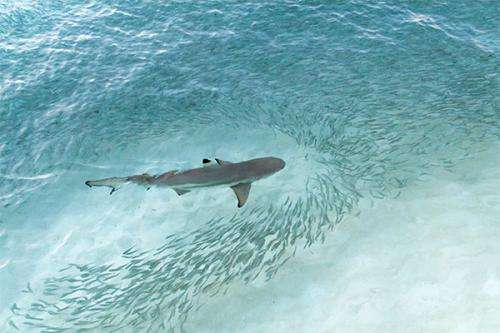Shark cull overkill

When West Australian (WA) Premier Colin Barnett sanctioned the killing of sharks longer than three metres that come within a kilometre of the shoreline, the decision was immediately met with fierce opposition. Professor of Marine Ecology David Booth from the UTS School of the Environment questions the effectiveness of shark culls and nets in ensuring public safety and the policy's long-term consequences on our marine environment.
Jaws certainly has a lot to answer for. Since its release in 1975, the film has instilled fear in beach-goers – and, evidently – politicians alike.
A nation-wide poll in January found 82 per cent of Australians disagreed with the controversial shark cull policy, with mass protests across the country following the first kill – a female tiger shark, baited and shot by a contracted fisherman. Those opposed stated the policy is cruel and not based on science, and I have to agree.
There is no evidence that killing sharks will reduce attacks on swimmers. It's clear the overall incidence of shark fatalities are not on the rise, especially given the large increase in swimmer numbers in the water over that time. While the south east corner of WA has been prominent in recent attacks (seven since 2010), only 20 fatal shark attacks occurred in WA waters since 1791. This is compared to 68 along the much-shorter NSW coastline. It's barely one fatality per year Australia-wide over that time; in comparison, over 120 bathers drown each year.
While drum lines and shark nets have been effective in reducing shark numbers close to popular beaches, there is a misconception as to what their function actually is. Rather than act as a barrier or fence, the purpose of these nets is to kill dangerous sharks, thereby reducing shark numbers and the chance of an attack.

The 2012 McPhee report on the matter to WA Fisheries noted due to the environmental impacts of shark control activities, it was not recommended that either shark nets or drum lines be introduced. Apart from the sharks themselves, other marine organisms are at risk. Shark control programs result in the capture of a wide range of by-catch species including marine mammals, marine turtles, and sharks and rays not implicated in unprovoked attacks on humans.
Rather than shark sightings instilling fear, they should be viewed as a sign of a healthy ocean ecosystem. It's now well established that as top predators, sharks are important in maintaining the resilience and integrity of ocean biological communities. For instance, large sharks have a key role in controlling smaller predators such as seals that may target commercial fish species.
Not only are sharks of priceless value to the oceans, they also bring in a huge amount of tourism revenue. Recreational diving and shark sighting expeditions feature heavily on many Australian tourism brochures. What message are we sending the world if we display such behaviour to one of Australia's most iconic species?
Yet despite being essential to a healthy marine environment, the world's shark populations are experiencing significant decline, with perhaps 100 million or more sharks being lost every year. The increased demand for shark meat and shark fin makes them especially vulnerable to overfishing.
According to The Australian Marine Conservation Society, the international trade in shark fin is widely believed to be responsible for causing the decline in so many shark populations around the world. They say Australia is complicit in driving our global shark populations closer to extinction by our role in the international shark fin trade (a single shark fin fetches $1000 in Sydney's or Melbourne's Chinatowns).
Compounding the problem is the fact that large sharks are long-living and have slow reproductive and growth rates, so they don't bounce back quickly from such intensive harvesting. Basically they're being caught faster than they can reproduce; most of our largest sharks have already been categorised as vulnerable or near-threatened by the International Union for the Conservation of Nature (IUCN).
What are more humane alternatives to reduce risk of shark attacks, given these large sharks are of high conservation and ecotourism value? Marine science research has advanced rapidly in the areas of shark detection and warning, and we can now accurately follow tagged sharks or detect them passing monitoring stations. Common sense also goes a long way. Sharks feed during dawn, dusk, and night, so stay out of the waters during those times if possible. Also avoid swimming in areas where people are fishing or where shark prey live.
With respect to all the families of shark attack victims – the latest being the death of a 28-year-old diver in Adelaide by a suspected great white – a more sustainable plan of action is needed for the conservation, harvest and management of sharks in our waters. The unknown effectiveness of shark removals, the bad global press damaging Australia's reputation as an ecotourism destination, and the risk to the ocean ecosystem of removing top predators prove local shark species are more valuable to our country alive than dead.
Provided by University of Technology, Sydney


















